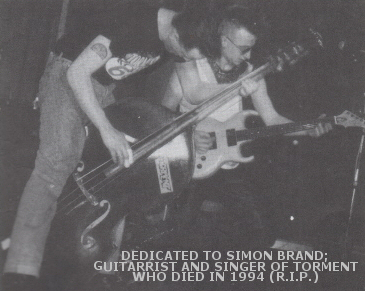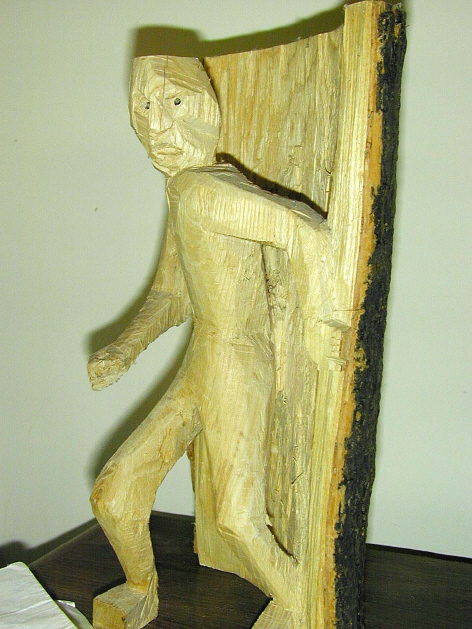|

Simon
Brand’s
life and death is arguably one of the most tragic stories of
Psychobilly. He was not only a very sublime guitarist,
singer and (co)-founder of two of the genre’s most
successful and most unique outfits but also one of the most
gifted and creative song-writers of the genre. But he also
was always dogged by self-doubts, mental unbalance and his
fatal relationship with his wife Wendy and so he decided to
take his own life before his 30th birthday.
Simon
Brand was born in Bristol on the 2nd
January 1965. His original family on his father´s side came
from Ireland and the surname was Brando, but the
family decided to change it to Brand, to sound more
English. His parents were and still are very religious and
belong to the denomination of the Christadelphians, which
was formed in the United Kingdom and Northern America in the
19th century. That’s how Simon was raised.
The Brands lived in a huge house in Kingswood, about
ten miles away from Bristol city .
The
teenager was very interested in what is now best known as
the British Rockabilly revival,
but also liked the Punk Rock
After
the Sharks split, Steve Whitehouse (b,
d, v) booked a local record studio and he and Simon Brand
(g, v ) recorded two demo tracks under the name Hellfire.
The songs were a cover version of Glen Glenn’s
Everybody’s Movin´ and a Simon Brand song entitled
Cry Or Die. Merv Pepler –who was also with Steve
Whitehouse in the Shakin´Quiffs-joined
the duo on drums and the three chose the new band name Frenzy.
The trio started to rehearse and recorded another demo
track, so-called Robot Riot. Their first live
performance was at The Juke Joint in Eindhoven,
Holland, in December 1983, where the band
also was offered a record deal by Klaas Westerbeek.
The 7´´ vinyl EP, released by Westerbeek´s new Cat
Machine Records included three tracks (Robot Riot,
Sweet Money and Frustration). Roy Williams
of Nervous Records get hold of the platter and
told Steve it was “ the best rockin´ track he had ever
heard”. He also signed the trio for their debut album Hall
Of Mirrors and for a four track 12´´ EP (Robot Riot,
All Alone, Cry Or Die, Torment) in
1984. But it turned out that Simon Brand and Steve
Whitehouse were having differences of opinion during the
year and Simon was asked- after several discussions-
to leave the band., even though the album wasn’t
finished. Kevin Saunders replaced him for the
remaining songs of the album
.
After
some months of musical inactivity Simon Brand met Kevin
Haynes at a gig of Kevin’s band The Joint Jumpers
in 1985 and the two fellows made a plan about new rockin´
band. They asked Sean Holder- who was also with the Joint
Jumpers- to fill in for the vacant spot at the
doghouse bass. The only thing left to find was a band name,
which was finally found on the flip side of the classic
12´´ EP release of Robot Riot , a recording from Simon
Brand’s days with Frenzy: TORMENT. The
trio started to rehearse in Sean Holder’s garage.
They also hired a manager in Nutty Dave, who finally
organised two gigs for the band in Brighton
on the 23rd December and another gig in Bristol on
Christmas eve.
Simon
Crowfoot, an old mate from Simon Brand, took
over the double bass in early 1986. Torment
made its record debut with a two track appearance (My Dream
/ The Source) on the compilation album Zorch Factor- One,
released by Nervous Records in spring of the same
year and the band started to thrive. Their debut album Psyclops
Carnival and the 12´´ EP Mystery Men were also
released in 1986 and the band also appeared on the Stomping
At The Klub Foot compilation album series. The band was
booked for touring on European mainland in early 1987 and
Torment also recorded their second full length album Three’s
a Crowd by end of the year. The album, which was
produced by Frenzy co-founder Steve Whitehouse,
hit the UK Independent Chart in December. The band
was in great demand and appeared at several big festivals on
the continent and frequently gigged at London's famous mecca
of Psychobilly the Klub Foot. Some more tracks for
compilation albums followed and their third album Round
The World was released in 1989. Hypnosis – Torment’s
fourth and final album- hit the record shops in 1990 and was
produced by Pete Gage. Simon Brand decided to
do some solo work and recorded a track about his break-up
relationship with his wife Wendy. The song Broken Home
was released on Zorch Factor 3 and he experimented
drum computer on this track. Torment appeared
on that album too with their version of the Big Band classic
Route 66. After a gig in Amsterdam Simon Crowfoot
decided to stay in the Netherlands. With the rest of the
band located in the UK, Simon Brand and Kevin
Haynes finally made the decision to replace him with Vince
Mildren and the new formed trio started to gig again,
including another tour on the continent in 1992.
Simon
Brand left the United Kingdom in 1993 and went to Amsterdam
(NL), where he find a home for a while. He was hoping to
forget about the breakdown of his marriage with Wendy
and he also left his two children in England. Then he moved
to Vermont, USA looking for work and tackle his mental
problems. The following year he made the decision to
relocate back to Britain and tried to rekindle his
relationship with his ex-wife Wendy, but it didn’t work
out. He was totally down and his parents admitted him to a
hospital whilst suffering another
depression. He never left this place again and was found
hanging from a tree in the grounds of the hospital.

This is a
self-therapeutic statue carved by Simon taken from
TruerWords
For
more details on Simon Brand check out Truer
Words.
For
Torment MP3 downloads check out Nervous
Records.
|